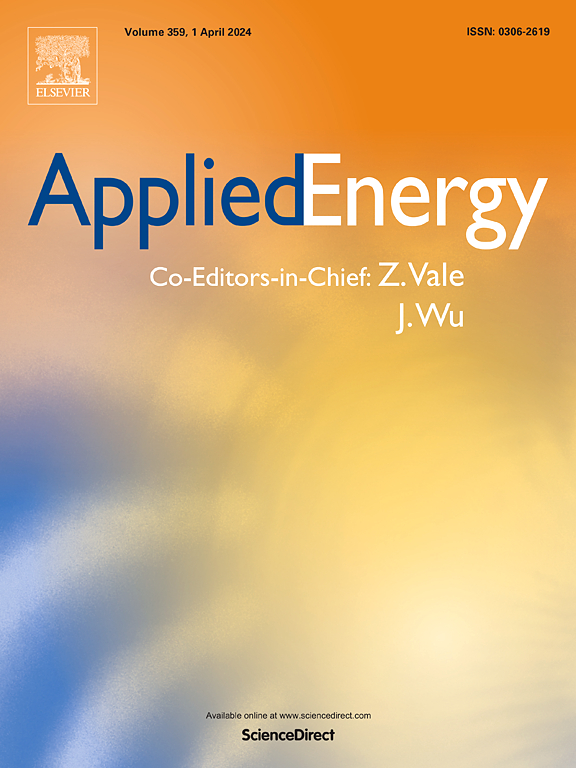可再生能源和LNG冷能驱动的离网绿色制氢和液化系统:综合4E分析与优化
IF 10.1
1区 工程技术
Q1 ENERGY & FUELS
引用次数: 0
摘要
为了满足日益增长的可持续制氢需求和减少氢液化的碳足迹,提出了一种集可再生能源、液化天然气冷能和有机朗肯循环为一体的离网系统。在TRNSYS中对可再生能源发电和质子交换膜电解槽制氢过程进行了建模,在ASPEN HYSYS中对氢液化和有机朗肯循环进行了模拟。基于能源效率、环境影响、能源效率和经济可行性,采用粒子群优化算法对氢液化过程进行优化。优化结果表明,系统比能耗由7.948 kWh/kgLH2降低到6.937 kWh/kgLH2。在4E分析框架中,案例10实现了最高的能源效率,达到23.55%,而案例1表现出最显著的污染物减少,相对于参考系统减少了2.901%的排放量。案例11表现出最佳的火用效率,为26.61%,而案例8以最低的初始投资优化经济可行性,动态投资回收期为3.56年,平均制氢成本为1.1美元/kgLH2。从双标准的角度来看,Case 8在生命周期成本和减排性能上优于其他案例,而Case 10则保持了优越的能源和用能效率。值得注意的是,案例5是等权重多准则评价下的帕累托最优解,以最小的折衷折衷平衡了所有性能指标。该集成系统为利用海上可再生能源制氢提供了一个有前途的解决方案,提供了低排放和可持续的燃料途径。本文章由计算机程序翻译,如有差异,请以英文原文为准。

Off-grid green hydrogen production and liquefaction system driven by renewable energy and LNG cold energy: A comprehensive 4E analysis and optimization
To address the growing demand for sustainable hydrogen production and reduce the carbon footprint of hydrogen liquefaction, an off-grid system integrating renewable energy, liquefied natural gas cold energy and organic Rankine cycle is proposed. The renewable energy generation and proton exchange membrane electrolyzer hydrogen production processes are modeled in TRNSYS, while the hydrogen liquefaction and the organic Rankine cycle are simulated using ASPEN HYSYS. The Particle Swarm Optimization algorithm is used to optimize the hydrogen liquefaction process by evaluating various configurations based on energy efficiency, environmental impact, exergy efficiency, and economic feasibility. The optimization results show that the system achieves a reduction in specific energy consumption from 7.948 to 6.937 . Within the 4E analytical framework, Case 10 achieves the highest energy efficiency at 23.55 %, whereas Case 1 demonstrates the most significant pollutant reduction, decreasing emissions by 2.901 % relative to the reference system. Case 11 exhibits the best exergy efficiency at 26.61 %, while Case 8 optimizes economic viability with the lowest initial investment, featuring a dynamic payback period of 3.56 years and a levelized hydrogen production cost of 1.1 $/. From a dual-criterion perspective, Case 8 outperforms others in life cycle cost and emission reduction performance, while Case 10 maintains superior energy and exergy efficiency. Significantly, Case 5 emerges as the Pareto-optimal solution under equally weighted multi-criteria evaluation, balancing all performance indices with minimal trade-off compromise. This integrated system provides a promising solution for utilizing offshore renewable energy in hydrogen production, offering a low-emission and sustainable fuel pathway.
求助全文
通过发布文献求助,成功后即可免费获取论文全文。
去求助
来源期刊

Applied Energy
工程技术-工程:化工
CiteScore
21.20
自引率
10.70%
发文量
1830
审稿时长
41 days
期刊介绍:
Applied Energy serves as a platform for sharing innovations, research, development, and demonstrations in energy conversion, conservation, and sustainable energy systems. The journal covers topics such as optimal energy resource use, environmental pollutant mitigation, and energy process analysis. It welcomes original papers, review articles, technical notes, and letters to the editor. Authors are encouraged to submit manuscripts that bridge the gap between research, development, and implementation. The journal addresses a wide spectrum of topics, including fossil and renewable energy technologies, energy economics, and environmental impacts. Applied Energy also explores modeling and forecasting, conservation strategies, and the social and economic implications of energy policies, including climate change mitigation. It is complemented by the open-access journal Advances in Applied Energy.
 求助内容:
求助内容: 应助结果提醒方式:
应助结果提醒方式:


